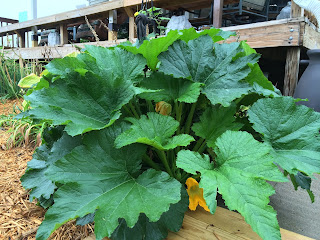 |
| Cucumber beetle-"bad bug" that spreads disease |
Saturday, July 26, 2014
There are good bugs and then there are the bugs that eat up your harvest or give your plants diseases. You have to be extremely careful in applying any insecticides (bug killers) as they will kill off the beneficial insects (like bees) that pollinate your veggies and increase your harvests.
There are also bugs, wasps and insects that kill the “bad bugs.” Using insecticides kills all insects and bugs, good and “bad”. If you use non-chemical methods of control for the first couple of years, your garden will come into balance. It can be very hard to resist the urge to get out the sprays, but there are other alternatives.
The best approach is to let nature take its course. If you have bad bugs, the good bugs will quickly follow and provide equilibrium in the garden. You can also purchase beneficial insects via mail order. If you go this route, be sure that you will be at home when they are delivered so that you can get them released as quickly as possible. Good bugs include parasitic wasps, assassin bugs, hover flies, lacewing, praying mantis, and ladybugs among others.
 |
| Ladybug eating aphids |
You can encourage good bugs by planting flowers either around your vegetable patch or actually with your vegetables. Marigolds are a “bad bug” deterrent. I plant these all around my flower garden.
You can also encourage birds to your yard by having trees, shrubs and flowers that attract birds. Keeping a bird bath with shrubs nearby so the birds can hide in the shrubs is a great way to get birds into your yard. Birds will be happy to eat as many bugs as they can find! For those that can, chickens or ducks provide the same service.
 |
| Stink bug-"bad bug" |
Using a garden hose to dose down the insects can be a good strategy; just make sure that you are not watering a plant’s leaves that are susceptible to fungal diseases such as tomatoes, cucumbers or zucchinis.
You can also go insect hunting and pull off the insects, larvae and caterpillars and throw them into a bowl with soap and water. I like the book “Good Bug, Bad Bug”. It has great pictures of both as well as pictures of them as caterpillars so you have a reference of both. You want to encourage the good bugs in your garden.
For Japanese beetles, I use an attractor that is quite a distance from the vegetable garden. They love roses so I go hunting for them on our roses every day. We also apply Milky Spore to keep the grub population down around the roses so we have fewer adults in the summer. It may take a couple of years for the spores to multiply in the ground, so don’t give up if the first year you don’t see a huge decrease in Japanese beetles.
For ants, you have to control the aphids. A recipe for catching the ants and aphids: 2 cups of vinegar, 2 cups of sugar, 2 cups of water in a gallon jug with a lid. Drill 3 small holes in the lid, large enough for the ants and aphids, but too small for a little bee. Place in trouble areas.
If you are just overrun with the bad bugs, you can look on OMRI web site to see what the organic insecticides are: http://www.omri.org/omri-lists I use Safer Insecticidal Soap and Neem Oil for my indoor plants.
Here are some make your own insect deterrents. Make sure you test on a few leaves to insure that it won’t adversely affect the plant you are trying to protect.
All purpose spray. 1 garlic bulb, 1 onion, 1 teas dry cayenne pepper, 1 teas liquid soap, 1 quart of water. Mix water, garlic, pepper and onion together in a food processor, let steep an hour or so, drain through cheesecloth, add liquid soap and you are ready to spray away!
Hot pepper spray. Good for repelling insects, squirrels, rabbits, and other curious mammals. 1 cup of hot peppers in a quart of water. Mix in food processor, strain through a cheesecloth and you are ready to use. Be careful to not get the liquid on your hands and then touch your eyes or mouth. It will burn.
Tomato-leaf spray. This is toxic to soft bodied insects like aphids. It also attracts beneficial wasps. Take the leaves off the bottom of your tomato plant, 2 cups. Put in food processor with 1.5 quarts of water. Let steep overnight, strain out leaves. Spray on affected leaves, especially the undersides where they like to hide.












